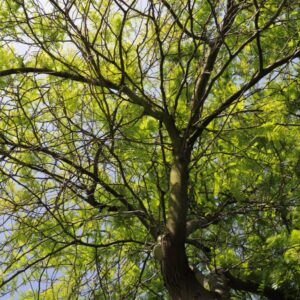Showing the single result
Wholesale Honeylocust Trees
Cold Stream Farm is a wholesale supplier of Hoeylocust trees based in Free Soil, Michigan. We ship Honeylocust transplants throughout the United States and Canada in various sizes and life stages. There is no minimum quantity required for wholesale or retail honeylocust tree orders from Cold Stream Farm.
What is a Honey Locust Tree?
We grow and supply wholesale Gleditsia triacanthos, which is commonly known as Honey Locust or Honey locust. Other nicknames for this species include common honeylocust, thorny honeylocust, or simply thorny locust.
Cold Stream Farm intentionally grows thornless honeylocust bushes from parent plants without thorns. Even so, it is still possible that small thorns may sprout on the trunk and branches of a “thornless” honeylocust tree.
Size and Appearance
A mature honey locust tree will usually reach a final size between 30 and 70 feet, with some plants growing to nearly one hundred feet in height. Sprouting outward and hanging down, the spread of a honey locust bush can be as large as 25 to 30 feet.
The trees bear fruit in the fall and flowers in the spring, with green leaves that turn a bright yellow hue at the end of each year.
In the wild, it is common to spot honey locust trees in the mid-western United States, with a natural range from east Texas, Oklahoma, and Kansas to Mississippi, Tennessee, and central Pennsylvania.
Ideal Honey Locust Growing Conditions
Honey locust trees are robust and capable of growing in a wide variety of conditions. They are very drought tolerant and highly resistant to salt-heavy areas and urban environments. Honey locust trees grow quickly, especially when planted in a location with full sun exposure.
In terms of soil, the honey locust grows best naturally in moist conditions, but the plant is very tolerant of compacted, alkaline, and nitrogen-poor soils. Geographically, honey locust trees grow best in USDA hardiness zones 4 to 10.
Why plant Gleditsia triacanthos?
Thanks to their fast growth rate in a variety of conditions, honey locust trees are often planted to quickly provide shade to an area. The large plants are both ornamental and functional, popular in housing developments, parks, reclaimed land, and other new growth areas.
As a very tolerant and durable species, honey locust trees can quickly add shade and color to roadsides, lawns, and other areas in need of vegetation. Their fast growth is not always valued, however, as landowners not monetizing the crop often view it as an invasive weed when competing for water with other species.
Edible Seed Pods
Beyond adding color and shade, several honey locust plant parts have been used for a variety of practical purposes. To start, the seed pods contain an edible pulp that can be enjoyed by humans and animals alike. Hiking around the Appalachian mountains, visitors can pick honey locust seed pods and chew the pulp raw or crush it into a sweet powder.
Beyond humankind, honey locust pods are also enjoyed by birds, livestock, and small animals such as squirrels and rabbits. Protection from pests may be necessary if you plan to keep the fruit all to yourself.
Use in Medicine and Research
Despite its name, the honey locust plant has been more commonly used in medicine and scientific research than as a natural sweetener. As a tea, honey locust pulp was used medicinally by several Native American tribes.
As a robust species, Gleditsia triacanthos plants have been used in phytochemical research and studies designed to fix nitrogen-heavy soil conditions.
Honey Locust Timber
Although it is rarely used in forestry or other bulk growing operations, there is a small niche market for honey locust timber. As a naturally durable material, wood from honey locust plants has been used in the construction of ships, railings, and furniture.
Common Issues with Honey Locust Trees
As a fan of warm, humid conditions, honey locust trees are not very frost tolerant and may perish if exposed to temperatures below freezing. If planted in the right conditions, however, it is very rare for honey locust growers to run into issues from infestations or other ailments.
How to Plant and Maintain Gleditsia Triacanthos
Plant your honey locust trees in full sunlight and water immediately. It is best to keep honey locust trees well-watered throughout their early life and the plant will become increasingly tolerant of drought conditions with age. In the same vein, fertilizers are most useful in the first few years of a plant’s growth.
Honey locust plants are very prune-tolerant, and branches can be easily cut to shape the tree and remove dead or diseased areas.
Purchase wholesale honey locust trees from Cold Stream Farm.
From our facilities in Free Soil, Michigan, Cold Stream Farm has limited honey locust inventory available for shipment throughout North America. To get started with your plants, please check the current availability of honey locust trees in our online store. If you have any questions about future availability or shipment, feel free to contact us about your next order.


